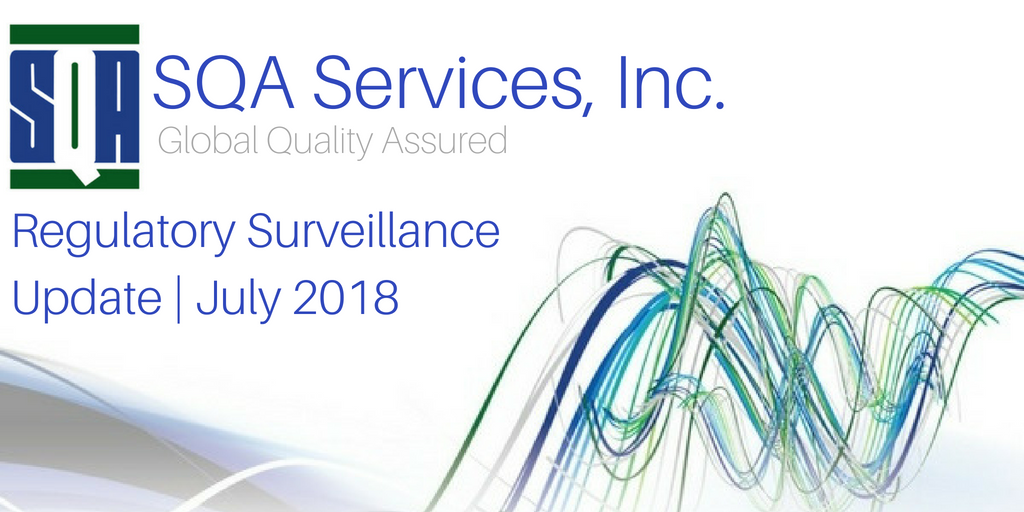United States Food and Drug Administration (US FDA) Guidances
Use of Electronic Health Record Data in Clinical Investigations: July 2018
US FDA has published a guidance for industry entitled Use of Electronic Health Record Data in Clinical Investigations: Guidance for Industry. The guidance provides recommendations for sponsors, clinical investigators, contract research organizations (CROs), institutional review boards (IRBs), and other interested parties on the use of electronic health record (EHR) data in FDA-regulated clinical investigations. The guidance finalizes the draft guidance that was issued in May 2016. This guidance is intended to assist sponsors, clinical investigators, contract research organizations, institutional review boards, and other interested parties on the use of electronic health record data in FDA-regulated clinical investigations. The guidance’s goals are to modernize and streamline clinical investigations through inclusion of real world data in clinical investigations and facilitate integration of clinical trials that occur in routine care settings. In addition, we hope that the guidance will encourage sponsors and health care organizations to work with EHR and electronic data capture (EDC) system vendors to further advance the interoperability and integration of EHR and EDC systems.
Use of Electronic Health Record Data in Clinical Investigations; Guidance for Industry
Field Alert Report Submission: Questions and Answers: July 2018
FDA published a draft guidance entitled Field Alert Report Submission: Questions and Answers. Field Alert Report Submission: Questions and Answers. Field Alert Report (FAR) regulations establish an early warning system to protect patient health. Under these regulations, applicants must submit certain product quality information regarding distributed drug products. Specifically, FARs concern information that may cause a drug product or its labeling to be mistaken for another article, or information related to contamination, significant chemical or physical changes or deterioration, or failure of distributed batches to meet specifications. This guidance provides the agency’s current thinking regarding the requirements for submission of field alert reports (FARs) by applicants of new drug applications (NDAs) and abbreviated new drug applications (ANDAs) and outlines FDA’s recommendations for FAR submissions to help increase their consistency and relevancy. The guidance also addresses certain frequently asked questions and provides additional clarifications regarding FAR submissions.
Field Alert Report Submission: Questions and Answers
United States Food and Drug Administration (US FDA) Recalls
Analysis of N-Nitrosodimethylamine (NDMA) Levels in Recalled Valsartan in the US: 27 July 2018
On July 13th, FDA announced a recall of certain batches of valsartan tablets because of an impurity, a chemical known as N-nitrosodimethylamine (NDMA). Valsartan is a medication commonly used to treat high blood pressure and heart failure. NDMA has been found to increase the occurrence of cancer in animal studies. These animal studies were done using amounts of NDMA much higher than the impurity levels in recalled valsartan batches. Based on these animal studies, the U.S. Environmental Protection Agency considers NDMA a probable human carcinogen a chemical that can increase the risk of cancer in humans. NDMA is found in some water supplies and in some foods. Consuming up to 96 nanograms NDMA/day is considered reasonably safe for human ingestion. It is estimated that over the course of a person’s lifetime, consuming this amount of NDMA would result in less than one additional case of cancer for every 100,000 people. To put this in context, currently one out of every three people in the US will experience cancer in their lifetime. The amounts of NDMA found in the recalled batches of valsartan exceeded these acceptable levels. The agency wanted to put some context around the actual potential risk posed to patients who used versions of valsartan that may have contained high levels of NDMA. Based on records from the manufacturer of the recalled valsartan, some levels of the impurity may have been in the valsartan-containing products for as long as four years. FDA scientists estimate that if 8,000 people took the highest valsartan dose (320 mg) from the recalled batches daily for the full four years, there may be one additional case of cancer over the lifetimes of these 8,000 people. This assessment led to FDA’s decision to have these batches recalled. Patients taking valsartan from a recalled batch should continue taking their current medicine until their doctor or pharmacist provides a replacement or a different treatment option. It is important to know that not all valsartan products contained NDMA, so pharmacists may be able to provide a refill of valsartan medication from batches that that are not affected by the recall, or doctors may prescribe a different medication that treats the same indications.
FDA Updates on Valsartan Recalls
AuroMedics Pharma LLC Issues Voluntary Nationwide Recall of Piperacillin and Tazobactam for Injection 3.375 grams per vial, Due to Presence of Particulates Identified as Glass and Silicone Material: 31 July 2018
AuroMedics Pharma LLC is voluntarily recalling two lots of Piperacillin and Tazobactam for injection, USP 3.375 g (Piperacillin Sodium equivalent to 3 g of Piperacillin USP and Tazobactam Sodium equivalent to 0.375 g of Tazobactam USP. Each vial contains 7.05 mEq (162 mg) of Sodium) in a Single-Dose vial, to the hospital level. One vial from lot# PP0317012-A was found to contain particulate matter, identified as glass within the vial and another vial from lot# PP0317059-A was found to contain silicone material. This problem was discovered as a result of two product complaints in which the contents of one vial from batch PP0317012-A was found to contain a glass particle and the contents of one vial from batch PP0317059A was found to contain a silicone particle.
Risk Statement: The administration of glass or silicone particulates may result in local irritation or swelling in response to the foreign material. More serious potential outcomes would include blockage and clotting in blood vessels, which may be life-threatening. To date, AuroMedics Pharma LLC has not received reports of any adverse events or identifiable safety concerns attributed to the product consumed from these lots.
https://www.fda.gov/Safety/Recalls/ucm615383.htm
United States Food and Drug Administration (US FDA) Warning Letters
Recently Posted Warning Letters
26 July 2018: CGMP/Food/Prepared, Packed or Held Under Insanitary Conditions/Adulterated
25 July 2018: CGMP/QSR/Medical Devices/Adulterated
Stanley Specialty Pharmacy Compounding and Wellness Center
24 July 2018: Drug Product/Adulterated
23 July 2018: CGMP/Finished Pharmaceuticals/Adulterated
18 July 2018: Labeling/False & Misleading Claims/Misbranded
17 July 2018: CGMP/Active Pharmaceutical Ingredient (API)/Adulterated
13 July 2018: CGMP/Dietary Supplement/Adulterated/Misbranded
12 July 2018: CGMP/Finished Pharmaceuticals/Adulterated
03 July 2018: Illegal Drug Residue
Association for the Advancement of Medical Instrumentation
AAMI TIR45:2012/(R)2018
AAMI TIR45:2012/(R)2018 provides guidance on the use of AGILE practices in the development of medical device software. Over the past several years, AGILE software development has become an accepted method for developing software products. There have been questions from both manufacturers and regulators as to whether (or which) AGILE practices are appropriate for developing medical device software. Enough medical device manufacturers have implemented AGILE practices in their software development so that answers to these questions can be documented. Having clear guidance of which practices have been found to be appropriate will be very useful for all developers of medical device software. This TIR will provide recommendations for complying with international standards and United States Food and Drug Administration (US FDA) guidance documents when using AGILE practices to develop medical device software.

